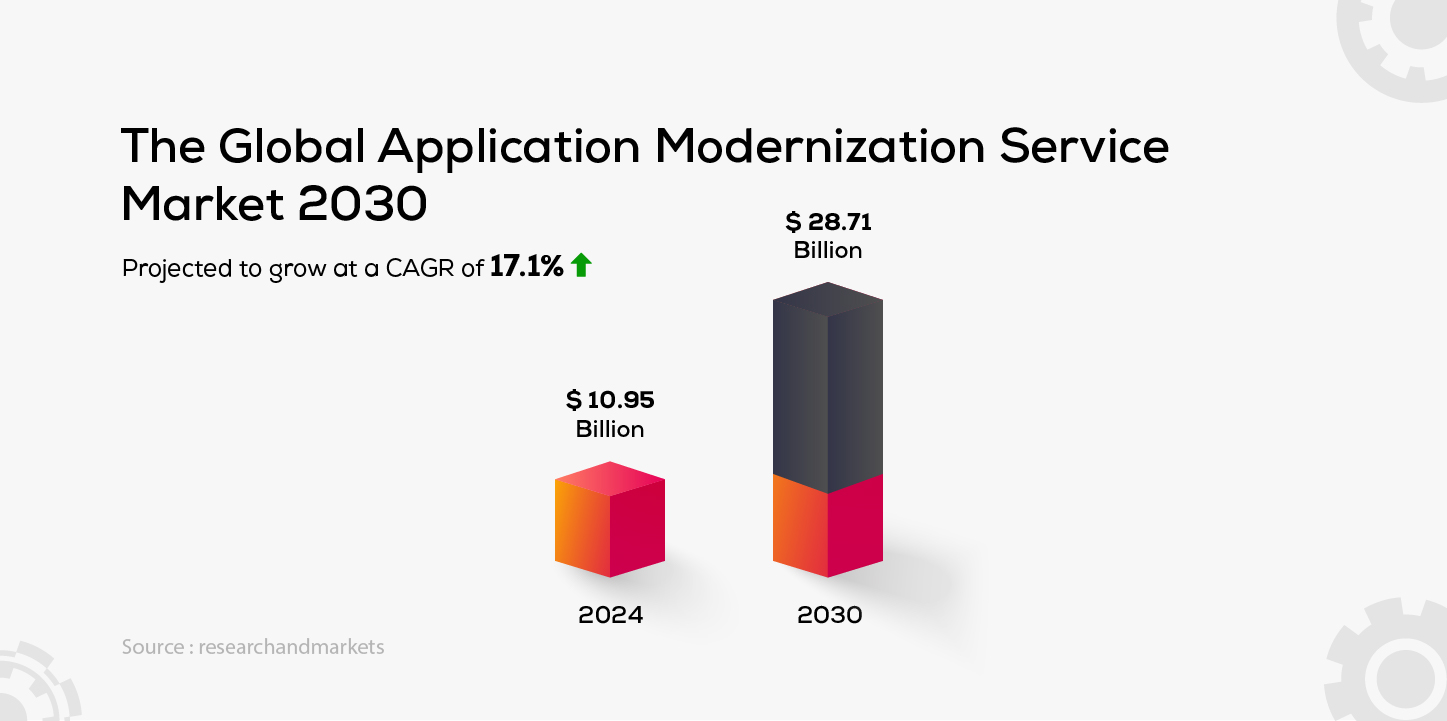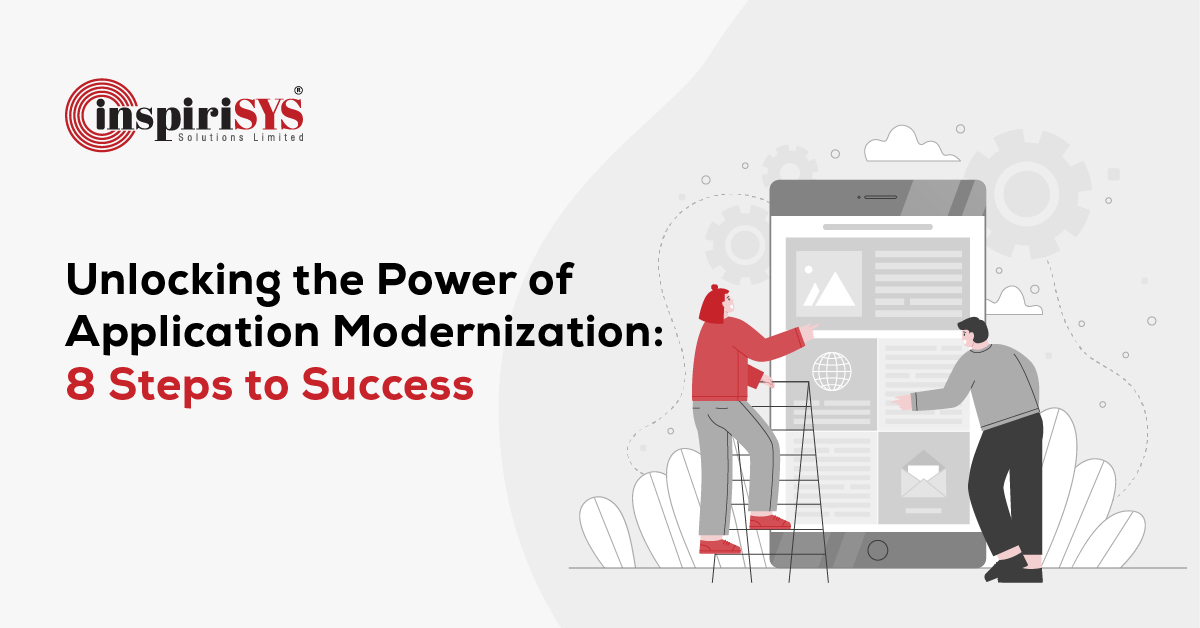Quick Summary: As businesses and IT operations undergo the process of automation, modernizing applications becomes critically important to stay ahead of the curve.
The software systems and programs that organizations use to conduct their businesses have changed dramatically over the years. These changes enable businesses to adopt new approaches, but they can also pose challenges for organizations trying to keep pace with evolving technology. One way to address this challenge is to start building new apps that are compatible with the latest technology stack.
However, the challenges are evident as they can be time-consuming and costly. Moreover, these challenges will persist, even with the most up-to-date applications.
Organizations can modernize their existing apps rather than building new ones from scratch. Before starting, there are certain questions you need to ask:
- Why should you modernize the legacy apps?
- Is the cloud suitable for my business needs?
- How will the existing applications be integrated with the newer ones?
Putting these questions into perspective, it's notable that the Application Modernization market, which was valued at USD 9.50 Billion in 2023, is expected to reach USD 10.95 Billion in 2024. It is also expected to grow at a CAGR of 17.11% to reach USD 28.71 billion by 2030.

So, let’s start by answering these questions in our blog.
What is Application Modernization?
Modernizing older applications involves updating the software to newer approaches, comprising newer languages, frameworks and infrastructure platforms. This is often called legacy application modernization. It can extend the lifetime of an organization’s application.
Updating outdated legacy systems can bring key organisational benefits, including:
- Reduced IT costs
- More scalable SaaS applications
- Improved speed and performance
- Easier management and maintenance
- Boosted data management
Recently, the conversation about cloud application modernization centres on monolithic, on-premises applications that are typically updated and maintained using the waterfall development process. These applicatins can be adapted to cloud architecture and release patterns, especially microservices and DevOps.
1. Cloud Application
Cloud-based data streamlines collaboration, across a wide range of tools, teams and applications, enabling efficiency and secure data collaboration. Organizations can manage costs and improve efficiency through cloud applications.
2. Containers
Containers are used to operate software in the cloud, which makes it easy to move between the environments and manage the applications. It delivers benefits such as securing modern applications and building them more efficiently and making them more accessible.
3. DevOps
DevOps is the combination of development and operations that enhances operational efficiency, improved software quality, customer satisfaction and market competition. To make modernization decisions DevOps uses monitoring, metrics and analytics.
Ready to explore further? Dive into the depths of the Top 20 DevOps tools and Metrics to gain a deeper understanding.
4. Data Warehouses
Modern data warehouses empower the entire organization to utilize the full potential of the data, thereby increasing security, scalability and flexibility. It ensures that the data is secure and readily available to the customers.
Are you eager to explore more? Delve into the difference between a Data Lake and a Data Warehouse.
5. APIs
The ability to share data between applications through APIs enables organizations to gain deeper insights and make informed decisions and user expectations. The APIs serve as the bridge between microservices in the cloud, enabling business agility and scalability.
Learn how APIs, Microservices, and DevOps can transform your business in our blog!
6. Low-Code/No-Code Development
To rebuild the existing app, low code/no code is the development trend that organizations should consider. The adoption of this platform increases faster time to market and pre-built components, resulting in reduced maintenance costs and faster delivery.
7. Artificial Intelligence (AI) and Machine Learning (ML)
AI and ML are the most popular technologies that help modernise the application. The adoption helps the teams to automate tasks, and analyse data, enhancing user satisfaction and efficient applications.
8. Microservices Architecture
It is a process of breaking the larger applications into smaller ones where the functions can be deployed, developed and scaled. Flexibility and scalability can be achieved by adopting microservices in business.
Benefits of Application Modernization
The modernized applications provide a software boost and the experience of agility, flexibility, and limitless possibilities. It’s all about uplifting the environment and standing aside in the digital revolution. It offers various benefits, including:
- Boost in productivity
- Improved mobility
- Greater speed and agility
- Better compliance
- Competitive edge
Explore more about the benefits of application modernization.
Common Challenges Faced in Application Modernization
Though modernizing the app offers several benefits, it also presents some challenges. Let’s take a detailed look at the challenges:
-
Cloud Migration Cost
The cost of developing apps poses a significant challenge for many organizations. Additionally, migrating to the cloud can present compatibility issues, particularly with unstructured data, which may result in data loss. Enterprises may also experience problems like corrupted data and skill shortages thereby resulting in high maintenance costs.
Solution: To make the entire process affordable, one must break the monolithic legacy applications into separate components. Further, hiring a development team with full-stack experience can be a solution.
-
Security Risks
Organizations face an increased risk of cyberattacks when they modernize legacy systems. The database structure's security threats can compromise business information during cloud migration. These security issues have diverse effects on businesses adopting this method.
Solution: The security risks can be eliminated by adopting a reliable partner. Connecting with an experienced organization helps to overcome security risks.
-
Modernizing Monolithic Applications
Another key challenge faced by the organization is modernizing the monolithic applications. Organizations find it complicated to modernize their IT systems due to technical debt, which is a major obstacle in the modernization process.
Solution: Using microservices can help break the monolithic structures. It allows for the building of a secure IT portfolio which helps make the migration process easier.
Application Modernization: 8 Steps to Success
In the ever-evolving world of digital space, modernizing legacy applications is a crucial step. Older applications can become barriers for organizations, as outdated technologies make it challenging for organizations to incorporate newer technologies into workflows, resulting in reduced efficiency. Let’s now understand the 8 steps to successful application modernization:
1. Assess the Current IT Environment
The primary step to achieving successful application modernization is to examine the IT environment. This involves reviewing the application’s infrastructure and technologies to identify and bridge any gaps in technology.
Assessing the IT environment allows us to prioritize and plan the modernization process, ensuring a smooth migration process. Aligning business goals with IT solutions helps mitigate potential risks. By incorporating this assessment, costs can be saved, and higher customer satisfaction can be achieved.
2. Identify Business Goals
Classifying the business goals is another important step in application modernization. To ensure that the IT transformation efforts are aligned with the goals, one must understand the business goals as well.
3. Selecting the Right Approach
Careful planning and selecting the right approach are crucial steps. The application modernization approaches include:
- Rehost
- Refactor
- Re-Architect
- Rebuild
- Replace
Learn more about streamlining your business with application modernization.
4. Listing Applications for Modernization
The fourth phase involves selecting and listing the applications. When evaluating an application for modernization, it’s important to consider factors like cost, delivery to customers and technical debt. By prioritising these factors, the list can be ranked accordingly.
5. Developing a Migration Plan
Once the right approach is selected and listed, the next important step is developing a migration plan. To avoid further confusion, the plan should undergo a sequence. The plan includes a series of steps including granting resources, setting timelines, implementing management strategies and defining roles.
6. Migration Execution
During the execution phase, the transformation of the applications takes place. This process can be technical as it requires significant coordination and technical work from different teams. Effective communication is the cornerstone for executing the migration as it keeps the stakeholders informed.
7. Testing Modernized Application
The testing phase is an important step to evaluate the work and deliver the business value. The different types of testing include:
- Functional Testing
- Integration Testing
- Performance Testing
- Security Testing
Continuous Testing is an important factor to consider for improved applications.
8. Monitoring the Modernized Application
After the application undergoes the testing phase, it’s time to monitor the modernized applications. To minimize disruptions to operations, the process should be gradual. To ensure it follows the business goals, it is important to have continuous monitoring in the process.
Conclusion
Modernizing the application is crucial to keeping pace with today’s business and IT operations. Though application modernization seems to be a complex process it is a necessary step for the business. Organizations should start closing legacy applications to have growth in future. Considering the benefits and steps to success, modernizing monolithic applications is a necessary process. The blog has examined application modernization, technological trends, benefits, challenges and steps to success. Transform your digital landscape today!







